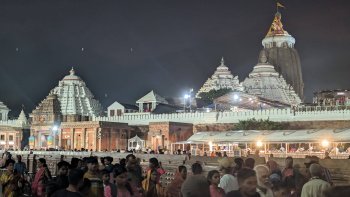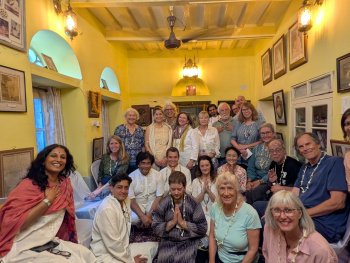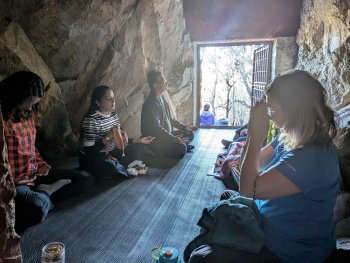A mild typhoon preceded our arrival in Puri via the Bhubaneshwar airport in the state of Odisha. The humidity and occasional downpour was a welcome change in weather for most pilgrims, and the seaside accommodations enjoyable for everyone. We stopped for another delicious lunch en route to our classy beachside hotel, the Mayfair.
Although our pilgrimage to places of great spiritual power continued, the general distinction between the teeming city of Varanasi and our relaxing beachside resort in Puri was a stark contrast: we arrived at the Mayfair with a big collective “relax and feel” breath.
Visiting the Karar Ashram of Sri Yukteswar is the spiritual highlight for the Yogananda devotee in Puri, however it is a city of great spiritual power and rich with the history of many yogi-saints and great devotion. Our glorious morning routine included sunrise energization, a bit of yoga/pranayam, chanting and meditation on the beach. Morning visits to pilgrimage sites gave way to free time in the afternoon for more yoga, relaxation, spa and gym time etc. The food was over-the-top and many pilgrims may have over-indulged in that department!

Other highlights in Puri included a visit to the enormous Jagannath temple. Although foreigners are not permitted inside, we circumambulated the temple complex to our great enjoyment and amusement. Over 10,000 priests serve here and up to a thousand cooks can serve upwards of 50,000 meals here daily! Jagannath is a form of Lord Krishna who is an incarnation of Vishnu, more recently incarnating as Mahavatar Babaji in our line of Gurus. Ultimately all is the One Spirit, but this special deity has tremendous spiritual power and millions upon millions of devotees come here to worship each year.

From Puri we made our way to Kolkata, my personal favorite place of pilgrimage. Besides being the home of our guru Paramhansa Yogananda, it has an especially unique cultural and spiritual environment. Through the centuries this area and city in West Bengal has been home to many saints, enlightened scholars, scientists, authors and sages. Yogananda’s own childhood stories in Autobiography of a Yogi are rich with many such mahatmas, or great souls, with colorful and fascinating context for the making of the great world Master that Yogananda would become.
The undeniable highlight for every Yogananda devotee here is the busy little neighborhood in which the great guru’s ancestral home, and that of his boyhood spiritual friend Tulsi Bose, sit just a half a kilometer apart. Both locations are supermagnets for countless streams of devotees who come seeking the blessings of prayer, meditation and reverence where Yogananda and many other great saints experienced the samadhi of enlightened oneness with God.

An unlikely meeting came together at our Kolkata hotel one evening when, with a little coordination, we were able to bring together three coinciding devotee groups: pilgrims from Ananda LA and Ananda Village, our pilgrims from Ananda WA and Ananda Portland, and several of the local devotees connected to our Ananda Kolkata center. We sang chants in Bengali, Hindi and English together, and felt tremendous inspiration at the spontaneous, international group of devotional hearts joining together. Murali and I shared about the work of Paramhansa Yogananda both as a personal and universal avatar for this age, and a Sat Guru of divine love, joy and wisdom. And off course a large and boisterous feast of joy and Indian food followed as our brief and delightful encounter with these international friends and gurubais came to a close.
Our final major pilgrimage stop in Kolkata sits across the Ganges river: the famous Dakshineshwar Kali temple where the spiritual powerhouse Sri Ramikrishna resided and worshipped for some 40 years. A fascinating feature of Ramakrishna’s life was the samadhi or oneness with God he sought by mystically delving deep into the major religious traditions of the world including Hinduism, Islam, Christianity and others. Although his realization of God ultimately transcended all forms, he long preferred to worship Divine Mother in the form of the goddess Kali and would ecstatically interact with her living presence. Years later Yogananda visited and also directly experienced the presence of the Divine Mother here. My own experience of visiting traditional Hindu temples, especially with such mystical power and history as Dakshineswar, is that the pilgrim or seeker can tap into the spiritual power there tangibly with focused attention before, during and after the ceremonial visit among throngs of people worshipping and seeking the blessing of darshan from the presiding deity.
Our final leg of the pilgrimage brought us to the Ranikhet region of the scenic Himalayan foothills, but not before a brief stop back in Delhi to regroup, see a few pilgrims off and gain a few more, and set off for a very long day of travel aboard train and bus. Leaving the poison air and pandemonium of the Delhi railway station behind we made our way some 5 hours to Kathgodam by rail, to board our bus and ascend another 6-7 hours up winding mountain roads. Many hours of devotional chanting and a spontaneous choir group filled our bus as we at last arrived at our final accommodations: the illustrious Dunagiri Retreat. This magical place sits just a few kilometers from our primary place of pilgrimage here, the sacred Babaji’s cave where Lahiri Mahashay was reunited with the deathless guru in 1862 and Kriya Yoga was reborn for millions of spiritual seekers in this era.
The fresh and frigid mountain air was a marvelous change, and the stunning views, sunsets and grounds of Dunagiri a feast of beauty for the eyes and heart. The food too (yes, the food again!) proved to be the most wholesome and enjoyable of our many wonderful places of nourishment, with many fresh, homegrown and local vegetables and traditional homemade hearty dishes. The proprietor was a splendid host and immediate friend to all, a kriya yogi of Yogananda and Babaji himself, who also worked at the World Bank in the USA for some 15 years before starting the humble Dunagiri retreat grounds 20 years ago. A daily toil of labor and love has made it the beautiful sanctuary it is now, including a Babaji meditation temple, spacious yoga hall, large and gorgeous atrium dining hall, sprawling terraced landscape and flower gardens, and comfortable if rustic accommodations.

Two consecutive mornings we hiked up to Babaji’s cave to meditate for hours within and along the beautiful hillside nearby. Our hiking was mostly in silence, practicing japa and devotional chanting to drink in the beauty of God in nature and the special blessings of the immortal Babaji. Many pilgrims experience profound meditation and spiritual communion here.
Finally we visited a nearby temple atop another towering hill, of the same name, Dunagiri, as our retreat. Legend says this special temple was also a meeting site of Babaji and his chief disciple Lahiri Mahashaya, as well as another ancient and sacred site of the Divine Mother in the small temple itself. Visiting these beautiful and powerful sites for just one or two hours, although remarkably special, would sometimes leave pilgrims pining to spend hours longer in devotional silence and meditation there.

We finished our time at Dunagiri with a fire ceremony in the special Babaji temple, chanting the ancient Mahamritunjaya Mantra 36 times with deep concentration, prayer and blessings filling our hearts. It was hard to leave and the bittersweet feelings continued as we retraced our route by bus and train back to Delhi for our closing satsang together. The blessings of this pilgrimage were so potently felt by everyone present.
Spiritual friendships and experiences were forged deeply in all hearts, and renewed inspiration and divine strength continues to blow like a mighty wind at the backs of all our pilgrims. Parting ways with our 20-day journey and one another proved hard on everyone, but the overwhelming feelings of gratitude, joy and blessings are the wings each pilgrim felt soaring their ways home. As a result, a rare spiritual gift like a precious gemstone now adorns each of our hearts forever.
